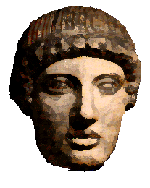Travel in Greece
Nemea
A song in the valley of Nemea:
Sing quiet, quite quiet here.
LAWRENCE DURRELL, Nemea
 Take the old national highway south from Ancient Corinth, and within
half an hour or so you will come upon the right turn for Ancient Nemea.
When I visited at the end of March 1997, further progress meant driving
along a narrow defile through a landslide - somehow this appropriately
symbolised the remoteness of this quiet and utterly peaceful valley, chosen
as a venue for one of the Big Four ancient Greek Games - held every two
years in between the Olympics. Then as now it would have been normally
quiet and unvisited - erupting briefly into pulsating activity only for
the period of the Games. The
University of Berkeley, California have been working on the Sanctuary
site (where the three columns of the Temple of Zeus have stood since the
4th century BC) and the stadium - now open at last to visitors. The museum
is is superbly laid out - with models of the site as it was which you
can compare directly with the view through the picture window.
Take the old national highway south from Ancient Corinth, and within
half an hour or so you will come upon the right turn for Ancient Nemea.
When I visited at the end of March 1997, further progress meant driving
along a narrow defile through a landslide - somehow this appropriately
symbolised the remoteness of this quiet and utterly peaceful valley, chosen
as a venue for one of the Big Four ancient Greek Games - held every two
years in between the Olympics. Then as now it would have been normally
quiet and unvisited - erupting briefly into pulsating activity only for
the period of the Games. The
University of Berkeley, California have been working on the Sanctuary
site (where the three columns of the Temple of Zeus have stood since the
4th century BC) and the stadium - now open at last to visitors. The museum
is is superbly laid out - with models of the site as it was which you
can compare directly with the view through the picture window.
The Nemean Games
The last Modern Nemean Games (first reveived in 1996) were held in June 2008. Details
here. The Nemean Games are open to ANYONE! Presumably they will also provide a commerce-free alternative to the London Olympics in 2012, although there's not much information available.
The Nemean Games aim to avoid the problems associated with the modern Olympics. The Society for the Revival of the Nemean Games believes that there is scope for the average person to participate in such an international athletic festival where no records will be kept and no medals awarded. Races organized by gender and age, and all participants will be rewarded only by feet sore from contact with the same stones and the same soil where ancient feet ran more than 2,000 years ago.

View of the valley of Nemea
Nemea in Mythology
Well, of course, this was where Heracles did his first labour, throttling the Nemean lion, and skinning it (it was invulnerable to weapons) with one of its own claws. But - apart from a dubious "lion's cave" there's nothing here to connect with Heracles.
The real Nemea myth is not so well known. The king was told that his baby son, Opheltes, must not be allowed to touch the ground until he could stand on it on his own two feet. Hypsipyle was hired to watch him night and day. One fine day, when she was carrying the boy through the meadows near the river, some fierce warriors approached, demanding water. They were Polynices, son of Oedipus, and the others of the "Seven" who were on their way to Thebes to challenge Eteocles, his brother. Hypsipyle rushed off to the river, putting baby Opheltes down carefully on a bed of wild celery (selinon). Presumably it would not have done simply to hand him to one of the Seven to hold! While she was away - disaster! A snake got the baby and killed him.
Hypsipyle and the boy's father were distraught - and the Seven obviously felt very bad about it too - so much so that they interrupted their journey to hold Funeral Games in his honour - for which ever after a crown of wild celery was the prize in the Nemean Games. After this poor start to their expedition, no wonder the Theban venture was a total fiasco. All the Seven lost their duels at the seven gates of Thebes, and Polynices was killed by his brother Eteocles.
SOURCE : Apollodorus 1.137

